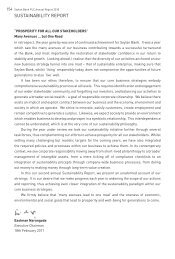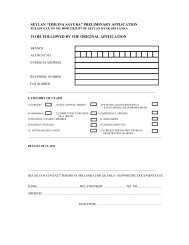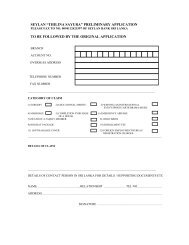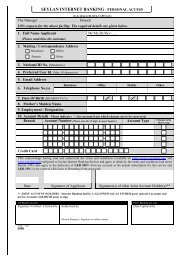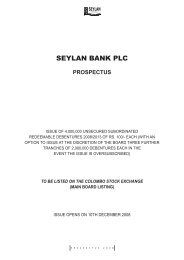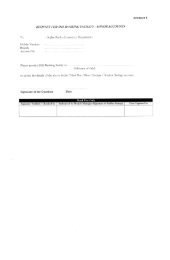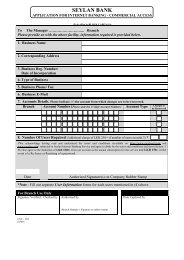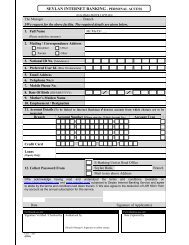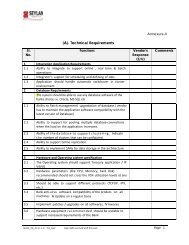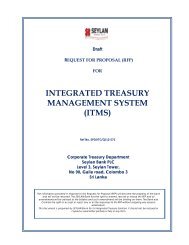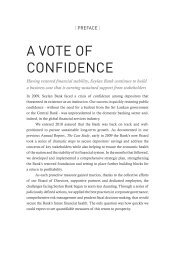The Case Study - Seylan Bank
The Case Study - Seylan Bank
The Case Study - Seylan Bank
You also want an ePaper? Increase the reach of your titles
YUMPU automatically turns print PDFs into web optimized ePapers that Google loves.
108<strong>Seylan</strong> <strong>Bank</strong> PLC Annual Report 2009Economic Impact<strong>The</strong> <strong>Bank</strong> is committed to generating both social andfinancial values. While generating financial valuefor our shareholders is one of the main activities ofthe <strong>Bank</strong>, we are also conscious of the larger socialobligations we have. This obligation is larger giventhat we provide a broad range of financial solutions toa wide range of customers from all social segments.We are conscious of the impact we have on all thesesocial segments and conscious of the impact ourproducts and policies have on the economy and societyin general.In this respect, the <strong>Bank</strong> seeks to generatevalue in all geographical regions of the countryand among all social segments. Creating newjobs; establishing new opportunities; designingspecially-tailored products and services; andempowering socially disadvantaged groups; are allpart of the <strong>Bank</strong>’s attempts in value creation.This part of the Report looks at the <strong>Bank</strong>’simpact on investors, customers and employees.<strong>The</strong> ‘Value Added Statement’ of the <strong>Bank</strong> showsthe wealth the <strong>Bank</strong> has created with regard to itscustomers, employees and shareholders and thecontribution of the Company to the Government’srevenue and the economy in general.<strong>The</strong> <strong>Bank</strong> generated a total value of Rs. 4.66 Bn.for the year under review as against Rs. 4.58 Bn.the previous year. This was distributed amonggovernment, the employees, and shareholders.Rs. 2.34 Bn. or 50.24% of the value generatedwas distributed among employees as compensation.Rs. 0.99 Bn. or 21.25% was paid to the Governmentby way of taxes, including the Special FinancialVAT. A sum of Rs. 1.33 Bn. was retained for furtherexpansion of the <strong>Bank</strong>’s activities.In the year under review, the <strong>Bank</strong> supporteda number of initiatives that had broad social goalsby way of loan facilities. A sum of Rs. 4.2 Mn. wasthe loan outstanding for water purification, watersupply and waste water management. A sum ofRs. 12.6 Mn. was outstanding for power generationincluding mini-hydro power projects.Value Added StatementValue added is the wealth the <strong>Bank</strong> has been ableto create by providing clients with a quality, valueadded service.Last year the <strong>Bank</strong> went through a crisisresulting from a sudden loss of public confidence. <strong>The</strong>Central <strong>Bank</strong> stepped into help stabilise the situationand appointed a new board of directors under thestewardship of the Executive Chairman. <strong>The</strong> <strong>Bank</strong> isproud to have confronted and overcome this crisiswithout any financial assistance from the State.InvestorsEarnings per share increased by Rs. 1.93 (214%)during the year under review. This was a result ofthe increase in profits by Rs. 388 Mn. <strong>The</strong> reasonsfor this are discussed more fully on pages … of theIncome Statement.<strong>The</strong> value that accrues to a shareholder isa combination of the dividend per share and theappreciation/depreciation of the value of a shareover the medium to long term.Employees<strong>The</strong> <strong>Bank</strong> has in place a market-based compensationscheme for its employees which is on par with therest of the industry. Statutory requirements arestringently observed.<strong>The</strong> <strong>Bank</strong> also provides medical insurancewhich covers most aspects of surgical and medicalillnesses to its staff. In addition, employees areeligible for a variety of other benefits which includeloans at concessionary rates and several otherwelfare facilities.All employees are entitled to benefits under theEmployees’ Provident Fund (EPF) and Employees’Trust Fund (ETF). In 2009, the <strong>Bank</strong>’s contributiontowards the benefits under the EPF and ETF wasRs. 229.34 Mn. and Rs. 57.30 Mn. respectively.<strong>The</strong> <strong>Bank</strong> has in place a comprehensiveretirement benefits plan accounted for as perSri Lanka Accounting Standard 16. <strong>The</strong> <strong>Bank</strong>measures the present value of the defined benefitobligation every year using the Projected Unit CreditMethod defined by the Actuary. <strong>The</strong> following aretaken into account by the Actuary when making theassessment: the existing interest rate; the rate ofincrease in salary and the retirement age of 55 years



